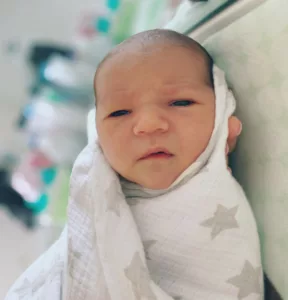
Babies with health problems differs in their sleep/ wake cycle. Preemies and sick babies sleep most of the time.
Their awake times vary around their actual due date or when they get stronger. It is best to avoid waking them as they need their sleep to grow and recover.
The development of a baby’s sleep/wake cycle is a complex process that involves many factors. Here’s a general overview of how this cycle typically evolves:
1. Newborn (0-3 months):
- Sleep Duration: Newborns sleep about 14-17 hours a day, with sleep periods lasting from a few minutes to several hours.
- Wakefulness: Newborns wake frequently due to their need for regular feedings.
- Cycle: There is no real pattern to a newborn’s sleep/wake cycle; they sleep and wake around the clock.
2. Infants (3-6 months):
- Sleep Duration: Babies of this age still sleep about 14-16 hours a day.
- Night Sleep: Sleep starts to become more consolidated, and infants begin to sleep more during the night.
- Naps: Naps start to become more regular during the day.
3. Older Infants (6-12 months):
- Sleep Duration: Babies typically sleep around 12-15 hours during this stage, including naps.
- Night Sleep: Nighttime sleep is more consistent, and most babies sleep through the night by this stage.
- Naps: Usually 2-3 regular naps per day.
4. Toddlers (1-2 years):
- Sleep Duration: Toddlers typically sleep 11-14 hours a day.
- Night Sleep: Nighttime sleep is more settled, with the child often sleeping through the night.
- Naps: Generally 1-2 naps per day, becoming more consistent.
5. Preschool (3-5 years):
- Sleep Duration: 10-13 hours a day is typical.
- Night Sleep: Nighttime sleep becomes even more consistent.
- Naps: Many children drop naps altogether by age 5.
Influencing Factors:
- Feeding Needs: The need for frequent feedings in the early months affects sleep patterns.
- Environment: The baby’s sleep environment can significantly influence sleep patterns.
- Developmental Milestones: Changes in physical and cognitive development can impact sleep.
- Parenting Choices: Parenting choices around sleep routines and habits can shape a child’s sleep patterns.
- Health Issues: Health issues, such as teething or illness, can disrupt sleep patterns.

Tips for the Parents
- Consistent Routine: Developing a consistent bedtime routine can help signal to your baby that it’s time to sleep.
- Safe Sleep Environment: Creating a safe, quiet, and dark sleep environment can support sleep.
- Understanding Growth and Development: Recognizing where your child is developmentally can help you support their sleep needs.
- Consultation: If you have concerns about your child’s sleep, don’t hesitate to consult with healthcare professionals.
Every child is unique, so these patterns may vary. Observation and adaptation to the individual needs and signals of your child are key to supporting their sleep development.
As a baby grows and develops, the awake time becomes more stable and predictable. Here are some signs that can indicate that the baby’s awake time is becoming more stable:
- Predictable Patterns: You might notice that your baby is waking and sleeping at roughly the same times each day. This indicates a more regular sleep/wake cycle.
- Longer Awake Periods: As the baby grows, they’ll stay awake for longer periods. This shows that they’re becoming more alert and engaged with their surroundings.
- Improved Mood During Awake Time: A more stable awake time often correlates with a happier, more content baby. They’ll be less fussy and more focused during playtime.
- Consistent Feeding Schedule: As awake times become more stable, feeding times often do as well. You may notice a more predictable pattern for when your baby gets hungry.
- Fewer Short Catnaps: Instead of falling asleep for short periods throughout the day, a baby with more stable awake times will have more defined naps at more consistent intervals.
- Increased Interest in Surroundings: As awake time stabilizes, the baby often becomes more curious and interested in the world around them. They may show increased focus and enjoyment in play and interaction with caregivers.
- Responsive to Sleep Cues: A baby with a stable awake time will show clear signs of sleepiness at predictable times, such as yawning, rubbing eyes, or becoming more fussy.
- Sleeping Through the Night: As the baby’s sleep/wake cycle matures, they may start sleeping longer at night without waking, indicating a more solid sleep routine.
- Response to Routine: If your baby starts responding positively to a consistent bedtime routine (like a bath, reading, or lullabies), it’s a sign that their internal clock is aligning with regular patterns.
It’s essential to note that babies are individuals, and there may be variations in these signs. Some babies may take longer to develop stable awake periods, while others may show these signs earlier. If you have any concerns about your baby’s sleep or wake patterns, it can be beneficial to discuss them with a healthcare provider, who can offer guidance tailored to your child’s specific situation.




